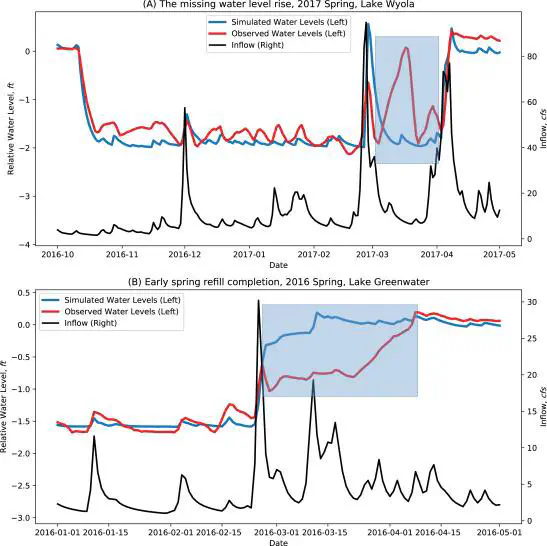Developing a stochastic hydrological model for informing lake water level drawdown management

Abstract
Winter drawdown (WD) is a common lake management tool for multiple purposes such as flood control, aquatic vegetation reduction, and lake infrastructure maintenance. To minimize adverse impacts to a lake’s ecosystem, regulatory agencies may provide managers with general guidelines for drawdown and refill timing, drawdown magnitude, and outflow limitations. However, there is significant uncertainty associated with the potential to meet management targets due to variability in lake characteristics and hydrometeorology of each lake’s basin, making the use of modeling tools a necessity. In this context, we developed a hydrological modeling framework for lake water level drawdown management (HMF-Lake) and evaluated it at 15 Massachusetts lakes where WDs have been applied over multiple years for vegetation control. HMF-Lake is based on the daily lake water balance, with inflows simulated by a lumped rainfall-runoff model (Cemaneige-GR4J) and outflow/release rate calculated by a modified Target Storage and Release Based Method (TSRB). The model showed a satisfactory performance of simulating historical water levels (0.53 < NSE < 0.86); However, uncertainties from meteorological inputs and TSRB determined lake outflow rate affected the result accuracy. To account for these uncertainties, the model was executed stochastically to assess the ability of study lakes to follow the state general WD guidelines: drawdown by Dec 1 and fully refilled by Apr 1. By using the stochastic HMF-Lake, the probabilities of each lake to reach the drawdown level by Dec 1 were calculated for different drawdown magnitudes (1 - 6 ft). Moreover, we employed the stochastic model to derive the annual latest refill starting dates that ensure a 95% probability of reaching the normal water level by April 1. These results provide lake managers with a quantitative understanding of the lake’s ability to follow the state guidelines. The model may be used to systematically evaluate current WD management strategies at state or regional scales and support adaptive WD management under changing climates.